Fabrication of Colorimetric Textile Sensor Based on Rhodamine Dye for Acidic Gas Detection
Abstract
1. Introduction
2. Materials and Methods
2.1. Materials and Instrumentation
2.2. Dye Synthesis
2.3. Geometry Optimization of the Dye
2.4. Solubility Test
2.5. Fabrication of Optical Textile Sensor
2.5.1. Dyeing
2.5.2. Printing
2.6. Gas Test of Fabricated Textile Sensor
2.7. Water-Repellent Finishing and Washing Test
2.8. Reversibility of Textile Sensors
3. Results and Discussion
3.1. Synthesis of a Novel Rhodamine Dye (RhYK)
3.2. Spectroscopic Properties of RhYK Dye
3.3. Gas Test of Fabricated Sensor
3.3.1. Dyed Sensor
3.3.2. Printed Sensor
3.4. Durability of Fabricated Sensors
3.4.1. Dyed Sensor
3.4.2. Printed Sensor
3.5. Reversibility of Fabricated Sensors
3.5.1. Dyed Sensor
3.5.2. Printed Sensor
4. Conclusions
Supplementary Materials
Author Contributions
Funding
Conflicts of Interest
References
- Van der Schueren, L.; De Clerck, K. The use of pH-indicator dyes for pH-sensitive textile materials. Text. Res. J. 2010, 80, 590–603. [Google Scholar] [CrossRef]
- Peter, C.; Zimmermann, D.; Knop, D.; Rademacher, S.; Schumacher, I.; Freund, I.; Wöllenstein, J. Investigations on work functions of gasochromic color dyes as gate materials for FET based gas sensors. Procedia Eng. 2014, 87, 108–111. [Google Scholar] [CrossRef]
- Zhang, C.; Li, Y.; Wang, W.; Zhan, N.; Xiao, N.; Wang, S.; Yang, Q. A novel two-nozzle electrospinning process for preparing microfiber reinforced pH-sensitive nano-membrane with enhanced mechanical property. Eur. Polym. J. 2011, 47, 2228–2233. [Google Scholar] [CrossRef]
- Agarwal, A.; Raheja, A.; Natarajan, T.S.; Chandra, T.S. Development of universal pH sensing electrospun nanofibers. Sens. Actuators B Chem. 2012, 161, 1097–1101. [Google Scholar] [CrossRef]
- Jaffar, A.F. Nonlinear Characterization of Rhodamine 610 dye-doped PMMA Thin Films Under 650 nm CW Laser Light Excitation. J. Al-Nahrain Univ. Sci. 2014, 17, 95–102. [Google Scholar] [CrossRef]
- Brackmann, U. Lambdachrome Laser Dyes, 2nd ed.; Lambda Physik Ink: Göttingen, Germany, 1986. [Google Scholar]
- Saha, J.; Dey, D.; Roy, A.D.; Bhattacharjee, D.; Hussain, S.A. Multi step FRET among three laser dyes Pyrene, Acriflavine and Rhodamine B. J. Lumin. 2016, 172, 168–174. [Google Scholar] [CrossRef]
- Zhou, Z.; Yu, M.; Yang, H.; Huang, K.; Li, F.; Yi, T.; Huang, C. FRET-based sensor for imaging chromium (III) in living cells. Chem. Commun. 2008, 29, 3387–3389. [Google Scholar] [CrossRef] [PubMed]
- Sunnapu, O.; Kotla, N.G.; Maddiboyina, B.; Asthana, G.S.; Shanmugapriya, J.; Sekar, K.; Singaravadivel, S.; Sivaraman, G. Rhodamine based effective chemosensor for Chromium (III) and their application in live cell imaging. Sens. Actuators B Chem. 2017, 246, 761–768. [Google Scholar] [CrossRef]
- Sunnapu, O.; Kotla, N.G.; Maddiboyina, B.; Singaravadivel, S.; Sivaraman, G. A rhodamine based “turn-on” fluorescent probe for Pb (II) and live cell imaging. RSC Adv. 2015, 6, 656–660. [Google Scholar] [CrossRef]
- Alessi, A.; Salvalaggio, M.; Ruzzon, G. Rhodamine 800 as reference substance for fluorescence quantum yield measurements in deep red emission range. J. Lumin. 2013, 134, 385–389. [Google Scholar] [CrossRef]
- Yang, Y.; Gao, C.; Li, B.; Xu, L.; Duan, L. A rhodamine-based colorimetric and reversible fluorescent chemosensor for selectively detection of Cu2+ and Hg2+ ions. Sens. Actuators B Chem. 2014, 199, 121–126. [Google Scholar] [CrossRef]
- Gupta, V.K.; Mergu, N.; Singh, A.K. Rhodamine-derived highly sensitive and selective colorimetric and off–on optical chemosensors for Cr3+. Sens. Actuators B Chem. 2015, 220, 420–432. [Google Scholar] [CrossRef]
- Jeong, J.W.; Rao, B.A.; Son, Y.A. Rhodamine-chloronicotinaldehyde-based “OFF–ON” chemosensor for the colorimetric and fluorescent determination of Al3+ ions. Sens. Actuators B Chem. 2015, 208, 75–84. [Google Scholar] [CrossRef]
- Yang, Y.; Gao, C.Y.; Zhang, N.; Dong, D. Tetraphenylethene functionalized rhodamine chemosensor for Fe3+ and Cu2+ ions in aqueous media. Sens. Actuators B Chem. 2016, 222, 741–746. [Google Scholar] [CrossRef]
- Wiley-Interscience Publication Staff. Kirk-Othmer Encyclopedia of Chemical Technology; Wiley Interscience Imprint: Hoboken, NJ, USA, 2004. [Google Scholar]
- Mokrzycki, W.S.; Tatol, M. Colour difference∆ E-A survey. Mach. Graph. Vis. 2011, 20, 383–411. [Google Scholar]
- McCullagh, J.V.; Kelly, A.D. Synthesis of triarylmethane and xanthene dyes using electrophilic aromatic substitution reactions. J. Chem. Educ. 2007, 84, 1799. [Google Scholar]
- Saini, J.; Garg, V.K.; Gupta, R.K.; Kataria, N. Removal of Orange G and Rhodamine B dyes from aqueous system using hydrothermally synthesized zinc oxide loaded activated carbon (ZnO-AC). J. Environ. Chem. Eng. 2017, 5, 884–892. [Google Scholar] [CrossRef]
- HAJ, M.M.; Chaichi, M.J.; Yousefpour, M. Solvatochromism effect of different solvents on UV-Vis spectra of flouresceine and its derivatives. Iran. J. Chem. Chem. Eng. 2008, 27, 9–14. [Google Scholar]
- Reichardt, C.; Thomas, W. Solvents and Solvent Effects in Organic Chemistry; John Wiley & Sons: Hoboken, NJ, USA, 2011. [Google Scholar]
- Habereder, P.; Attila, B. Part 2: Silicone softeners. Rev. Prog. Color. Relat. Top. 2002, 32, 125–137. [Google Scholar] [CrossRef]
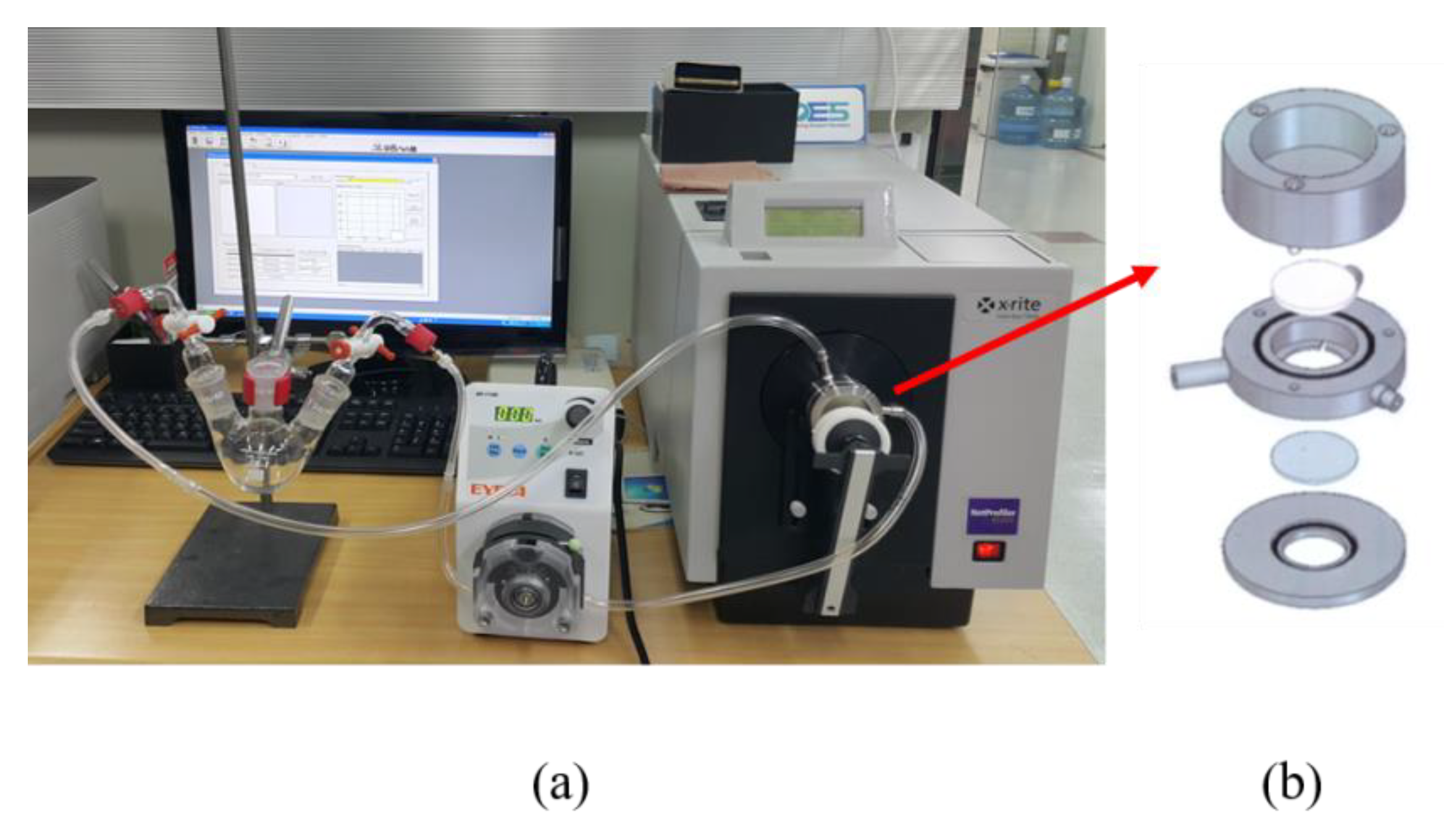

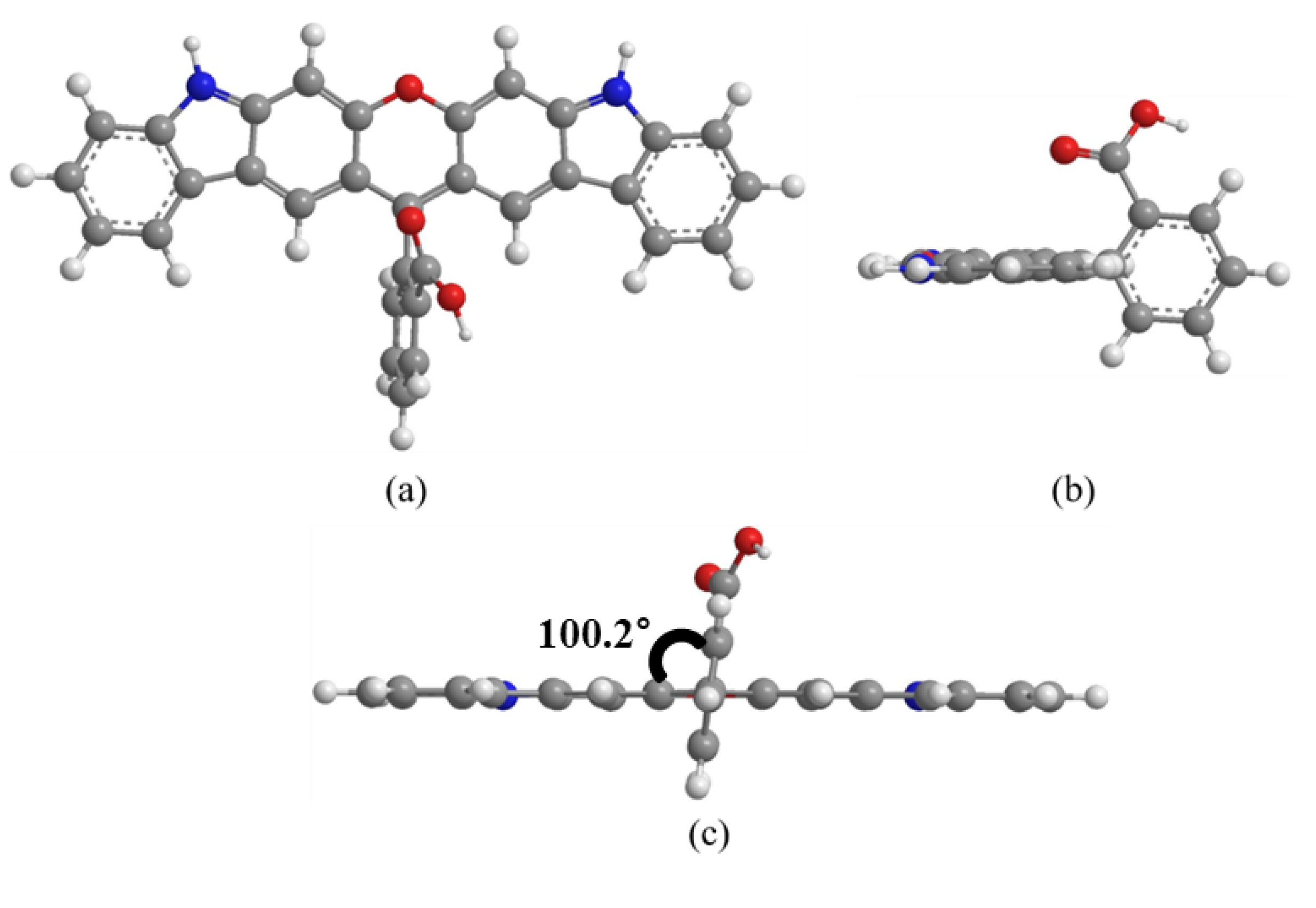
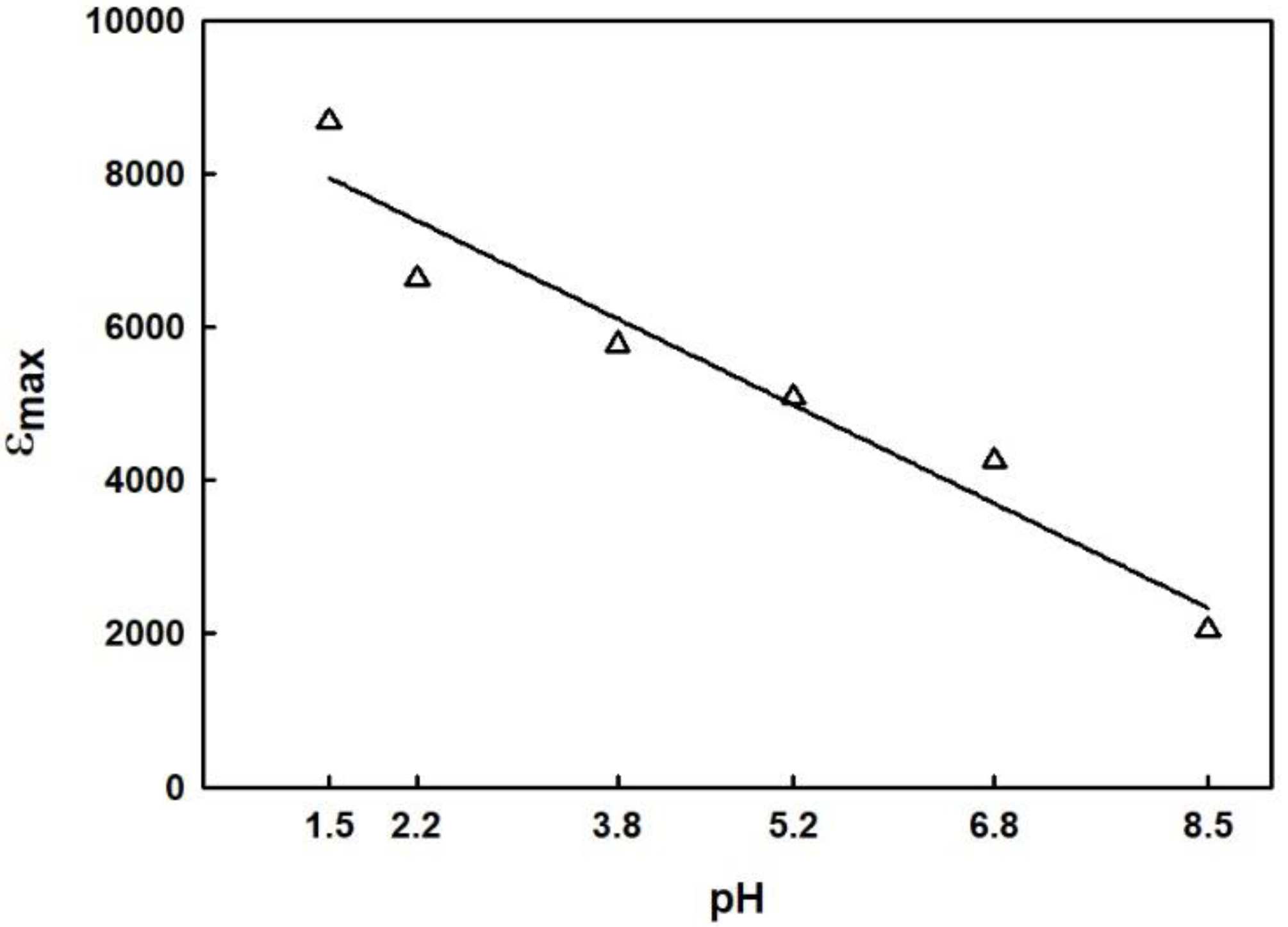


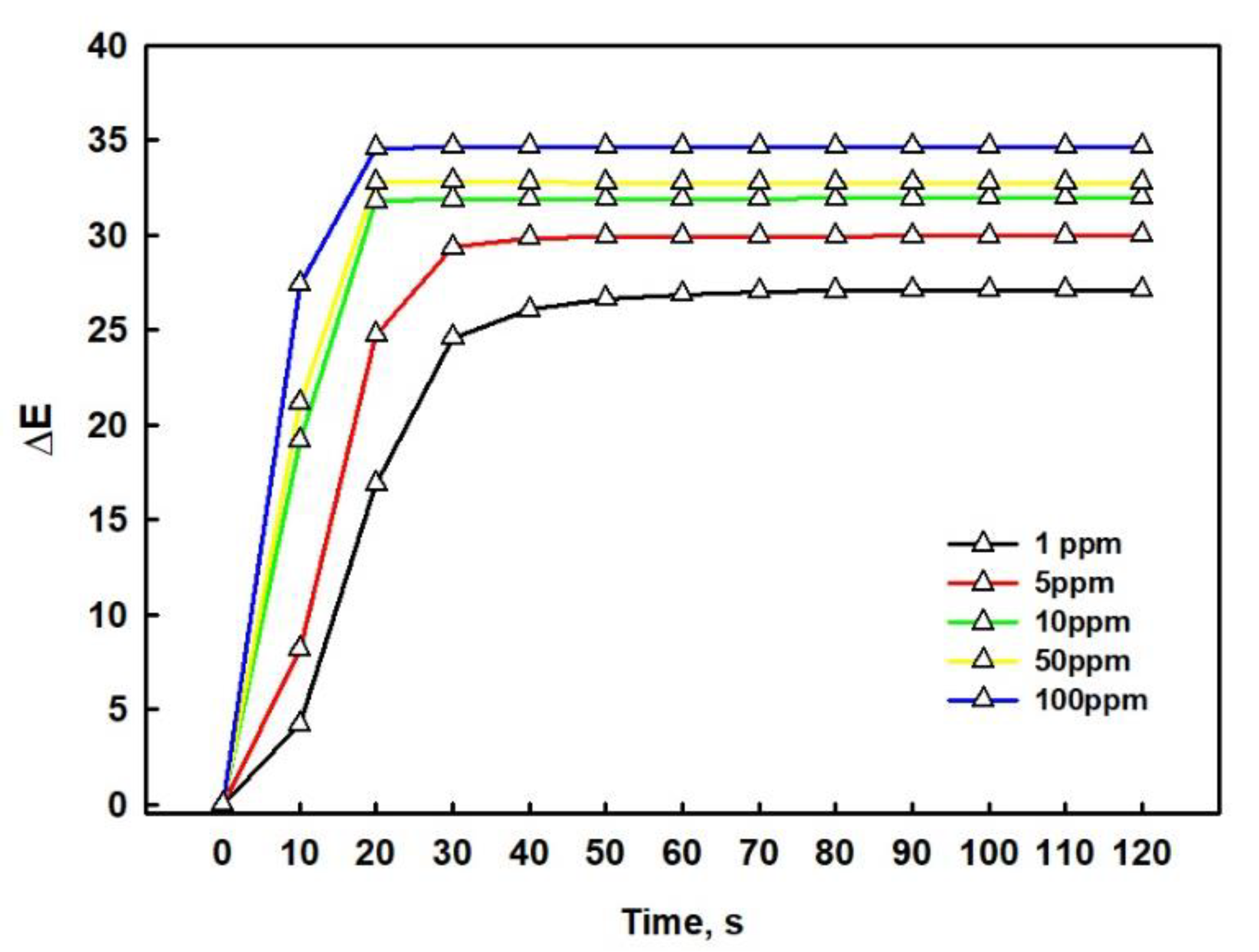
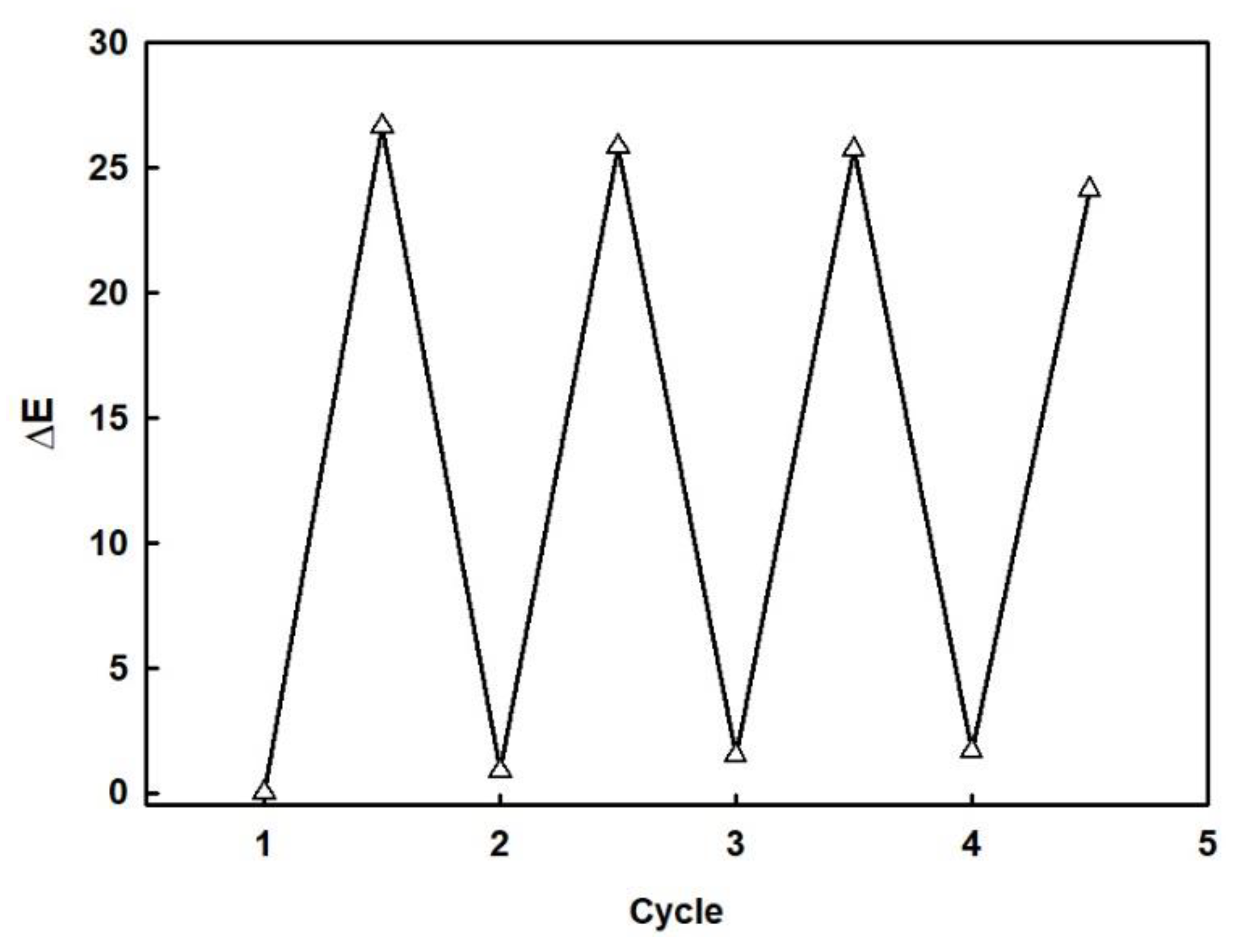
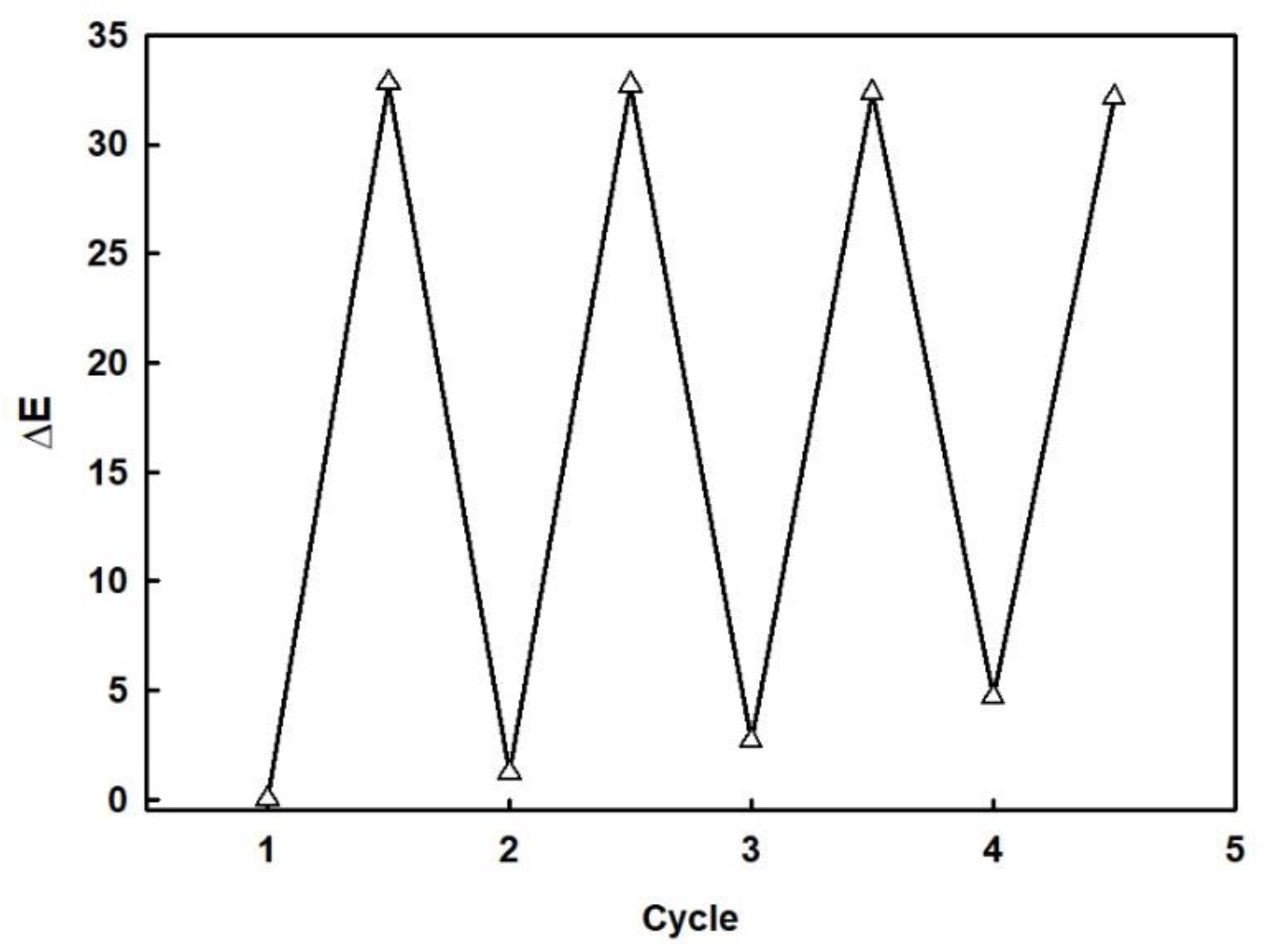
| Solvents | λmax (nm) | εmax (M−1cm−1) | Polarity Index | Solubility |
|---|---|---|---|---|
| MeOH | 537.5 | 4260.54 | 5.1 | + |
| EtOH | 540.5 | 4256.71 | 5.2 | + |
| DMF | 542.5 | 517.24 | 6.4 | +++ |
| DMSO | 543 | 572.80 | 7.2 | +++ |
| ppm | Before | 1 | 5 | 10 | 50 | 100 |
|---|---|---|---|---|---|---|
| Color at ΔEmax |  |  |  |  |  |  |
| Time at ΔE > 5 | - | <20 s | <10 s | <10 s | <10 s | <10 s |
| ΔEmax | - | 21.96 | 25.59 | 25.96 | 29.14 | 31.05 |
| ppm | Before | 1 | 5 | 10 | 50 | 100 |
|---|---|---|---|---|---|---|
| Color at ΔEmax |  |  |  |  |  |  |
| Time at ΔE > 5 | - | <10 s | <10 s | <10 s | <10 s | <10 s |
| ΔEmax | - | 27.10 | 29.99 | 30.39 | 32.74 | 34.65 |
| ppm | Untreated | Washed | Finished | Finished & Washed |
|---|---|---|---|---|
| Time at ΔE > 5 | <10 s | <10 s | <10 s | <10 s |
| ΔEmax | 25.96 | 25.60 | 29.40 | 27.68 |
| Initial—Saturated K/S at 550 nm | 0.05–0.62 | 0.04–0.52 | 0.04–0.69 | 0.04–0.64 |
| ppm | Untreated | Washed | Finished | Finished & Washed |
|---|---|---|---|---|
| Time at ΔE > 5 | <10 s | <10 s | <10 s | <10 s |
| ΔEmax | 30.39 | 29.52 | 30.86 | 32.32 |
| Initial—Saturated K/S at 550 nm | 0.11–1.30 | 0.09–1.07 | 0.15–1.61 | 0.09–1.31 |
© 2020 by the authors. Licensee MDPI, Basel, Switzerland. This article is an open access article distributed under the terms and conditions of the Creative Commons Attribution (CC BY) license (http://creativecommons.org/licenses/by/4.0/).
Share and Cite
Park, Y.K.; Oh, B.M.; Jo, A.R.; Han, J.H.; Lim, J.Y.; Oh, H.J.; Lim, S.J.; Kim, J.H.; Lee, W.S. Fabrication of Colorimetric Textile Sensor Based on Rhodamine Dye for Acidic Gas Detection. Polymers 2020, 12, 431. https://doi.org/10.3390/polym12020431
Park YK, Oh BM, Jo AR, Han JH, Lim JY, Oh HJ, Lim SJ, Kim JH, Lee WS. Fabrication of Colorimetric Textile Sensor Based on Rhodamine Dye for Acidic Gas Detection. Polymers. 2020; 12(2):431. https://doi.org/10.3390/polym12020431
Chicago/Turabian StylePark, Young Ki, Byeong M. Oh, A Ra Jo, Ji Hyeon Han, Jee Young Lim, Hyun Ju Oh, Seung Ju Lim, Jong H. Kim, and Woo Sung Lee. 2020. "Fabrication of Colorimetric Textile Sensor Based on Rhodamine Dye for Acidic Gas Detection" Polymers 12, no. 2: 431. https://doi.org/10.3390/polym12020431
APA StylePark, Y. K., Oh, B. M., Jo, A. R., Han, J. H., Lim, J. Y., Oh, H. J., Lim, S. J., Kim, J. H., & Lee, W. S. (2020). Fabrication of Colorimetric Textile Sensor Based on Rhodamine Dye for Acidic Gas Detection. Polymers, 12(2), 431. https://doi.org/10.3390/polym12020431





